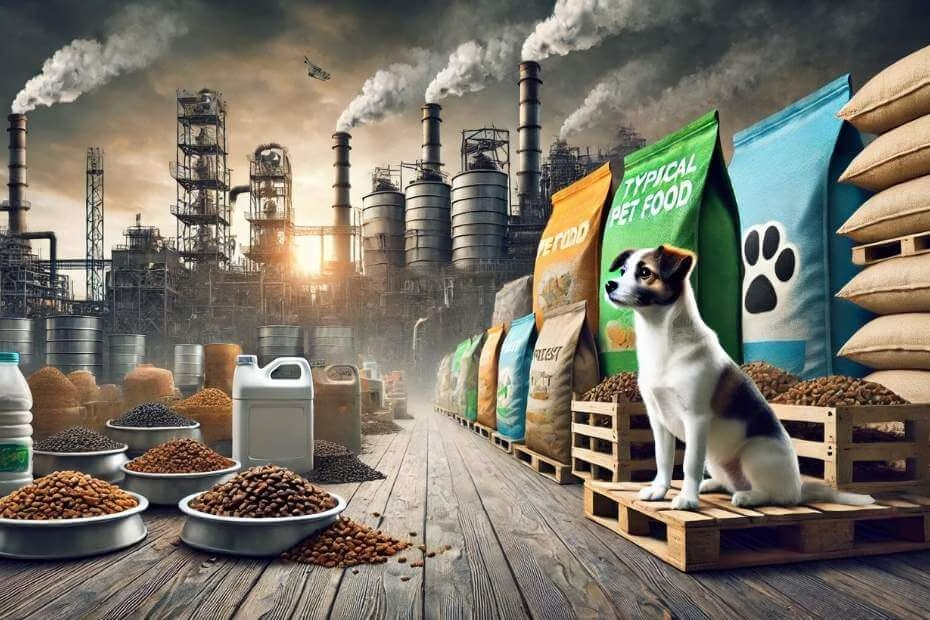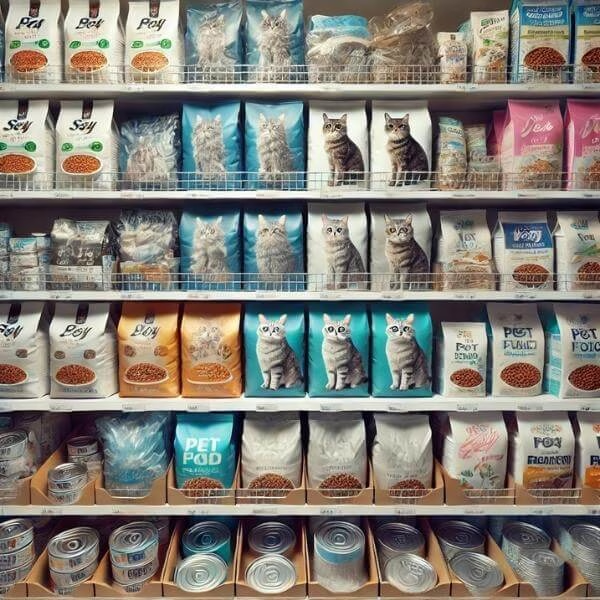Have you ever thought about what’s actually in those bags and cans of pet food sitting on store shelves? Most commercial pet foods mix ingredients, from animal proteins like chicken, beef, and fish to grains and vegetables. And while labels might claim ‘premium’ or ‘natural,’ the reality is more complex when it comes to your pet’s diet and the planet.

The Problem with Low-Quality Ingredients
Beyond just environmental concerns, it’s worth noting that some commercial pet foods contain low-quality ingredients like by-products, fillers, or artificial additives. Not only do these ingredients often come from unsustainable sources, but they also may not provide the best nutrition for pets. Choosing higher-quality, environmentally responsible brands can help ensure a diet that benefits both the planet and your pet’s health.
The Environmental Cost of Manufacturing Pet Food
Crafting the pet food we find so readily available involves a factory line that’s hungry for energy. Whether it’s the drying process for kibble or the cooking of wet foods, these methods pull a fair amount of power from the grid. This not only amps up production costs but leaves an environmental footprint that’s anything but small, with numerous facilities operating around the clock.
Waste is another by-product that often gets swept under the rug. The ecological cost can add up, from the emissions released during cooking and processing to leftover materials that didn’t make the cut. Recognizing these hidden impacts helps us make more mindful choices.
The Lifecycle of Pet Food Packaging
Packaging might seem purely functional or marketing-focused, but it plays a significant role in the environmental impact of pet food. Plastic bags, aluminum cans, and mixed-material pouches are common in the industry, and unfortunately, many of these materials aren’t recyclable. Biodegradable or recyclable options are still scarce in the pet food world, meaning that most packaging ends up in landfills.

Opting for brands that use sustainable packaging or buying in bulk (to reduce waste) can help mitigate this issue. Every small step contributes to reducing the long-term environmental burden of plastic waste.
Supply Chain and Transportation Effects
When we think about how pet food gets to our homes, it’s easy to overlook the journey it makes. Transporting these products, often sourced globally, racks up a hefty carbon footprint. Ingredients may travel halfway around the world before reaching the factory, and once manufactured, the finished products are shipped to warehouses and retailers. Each stage contributes to emissions and environmental degradation.
Some companies are stepping up with innovative strategies to reduce transportation’s impact. From local sourcing to more energy-efficient shipping methods, these efforts make a difference. As consumers, supporting brands that prioritize sustainability in their supply chains can encourage more companies to adopt these practices.
Third-Party Certifications: What to Look For
For eco-conscious consumers, certifications can serve as helpful indicators of a brand’s commitment to sustainable practices. Labels like USDA Organic, Rainforest Alliance, and Fair Trade indicate that a product or its ingredients meet specific environmental and ethical standards. Checking for these certifications can make identifying companies that genuinely prioritize sustainability easier.
Animal Welfare and Ethical Considerations
It’s also important to consider the ethical implications of sourcing pet food ingredients. Many animal products come from factory farms, which often have a large carbon footprint and may not treat animals humanely.
Some pet food companies are adopting more humane practices, sourcing ingredients from farms that prioritize animal welfare. Supporting brands that are transparent about their sourcing practices can help align pet care with a commitment to the ethical treatment of animals.
Exploring Sustainable Alternatives in Pet Food
With environmental impact in mind, a growing number of pet food brands are focusing on eco-friendly practices. Companies like Purina and Wild Earth are making strides in sustainability. Purina, for instance, has achieved 100% renewable electricity use at all its U.S. manufacturing sites and has taken steps to reduce water usage. Wild Earth is known for its plant-based formulas, which reduce the environmental toll of traditional meat production.
These pioneers are setting the bar high with their sustainable practices, showing that pet food can be nutritious for our pets and considerate of the environment. Choosing brands that invest in sustainable options contributes to a cleaner, greener future for us all.
Curious about how a plant-based diet can benefit your pet? Check out our guide to plant-based diets for pets.
Research and Act
If you’re unsure about your pet food’s environmental impact, take the time to research. Look up your favorite brands, check for certifications, or even contact companies to ask about their sustainability practices. By actively seeking eco-friendly options, you’re making better choices for your pets and contributing to a larger movement toward environmental stewardship.
Adopting a sustainable approach to pet care is about making informed choices that benefit both your pets and the planet. Every purchase matters; with some research, you can find options that align with your values. Let’s work together to ensure that our furry friends can thrive without compromising the world they play in.
Many pet owners who have switched to sustainable pet food options report feeling more aligned with their values and often notice an improvement in their pets’ health.
Practical Tips for Eco-Friendly Pet Food Choices
Reducing the environmental impact of pet food doesn’t have to mean a complete overhaul. Small, thoughtful changes can make a difference. Here are some practical tips to help you get started:
- Buy in Bulk: When possible, opt for bulk pet food purchases. Many stores offer the option to buy larger quantities, which reduces the frequency of packaging waste. Some locations even allow you to bring your own containers to refill.
- Use Reusable Containers: Instead of storing pet food in disposable bags, transfer it to airtight, reusable containers. This reduces plastic waste and helps keep the food fresh for longer.
- Look for Sustainable Packaging: Seek out pet food brands that use recyclable or compostable packaging materials. Many eco-conscious companies are now offering biodegradable bags or recyclable cans, which can significantly reduce waste compared to traditional plastic packaging.
- Research Brand Practices: Choose brands committed to sustainable practices. Look for transparency in sourcing and packaging, and consider brands that prioritize ethical and environmentally friendly production methods.
- Support Local and Sustainable Brands: Consider supporting local or smaller sustainable pet food brands whenever possible. By reducing transportation distances, local products can help minimize the carbon footprint associated with shipping.
By making small, intentional changes in how we buy and store pet food, we can contribute to a cleaner, greener planet while still providing the best for our pets.
